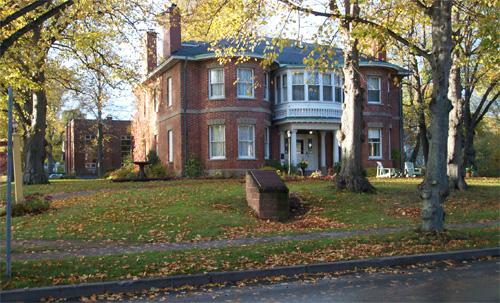It appears the church is under construction - an amazing photo to say the least. I see lots of interesting details - from the brick foundation (brick above, cut sandstones below grade) to the three left second floor windows yet to receive their sashes - from the gables featuring gothic style palladian windows to the braces and ladders for shingling the roof. I speculate the men shown here just finished the chimneys - you can see a pile of brick way in front of them and the barrels likely held mortar mix, etc.

Here are comments on Facebook about the building...
D.MacE. - Epworth
Hall across from Trinity United Church. They tore it down to build a
parking lot and added the new hall onto the church. There is a cairn
there with the following inscription: "Site of the first Protestant Church in Summerside, later known as Epworth Hall, 1860-1983."
L.L. - I| went to United Church Youth group there every Friday in the late '70s...Me, Nelson Snow, Kevin Murphy, Mary MacLeod...the pastor's name was Gary something. He was great.
Anyone else remember that? There was a back room on the second floor
where we met.
****************************
Also, this house is listed with Historic Places - see website...http://www.historicplaces.ca/en/rep-reg/place-lieu.aspx?id=11265&pid=14006&h=90,Spring,Street%20(4)
Above: Southeast Elevation. Photo taken 1982. Demolished in 1983.
Below info cf. Historic Places website.
Below info cf. Historic Places website.
This
site located on the northwest corner of Spring and Winter Streets is the former
site of the Epworth Hall. It is now a parking lot for the nearby Trinity United
Church. The site of the former hall is commemorated in a small grassed area
with two maple trees and a sandstone cairn with flowers in front. A plaque on
the cairn faces the intersection. Its inscription reads: "Site of the
first Protestant Church in Summerside, later known as Epworth Hall,
1860-1983."
A very large Greek Revival influenced
wooden structure known as Epworth Hall once stood on the northwest corner of
Spring and Winter Streets. When it was torn down in 1983 its historical
significance was commemorated with a stone cairn facing the intersection.
The Methodist Church originally
was opened on the north side of First Street in 1860 on land donated by Joseph
Green. This is shown in an 1887 engraving from the Journal Pioneer newspaper.
Around 1871, another Methodist group - the Bible Christians - decided to erect
another building on Spring Street. This was a group which had emerged from the
Methodist Church. The 30 by 50 foot church was constructed in 1874 and may have
been built by John Cudmore, one of the leading members of the congregation. It
was one of eight churches in the town at the time. In 1884, the Bible
Christians and three branches of Methodism in Canada came together to form the
Methodist Church in Canada. The local congregations thus combined under one
minister and the building henceforth became known as the Summerside Methodist
Church.
In 1894, the
congregation opened a new church (now known as Trinity United) on the opposite
corner to the south and the earlier structure was converted into a meeting hall
and Sunday School classrooms. In the fall of 1894, the building formally became
known as Epworth Hall. A branch of the Epworth League had been organized in
Summerside in January 1890. This was a youth organization which began in
Cleveland, Ohio in May 1889. An 1891 newspaper, described the League as "a
temperance and literary organization, with a course of lectures and
entertainments."
Major repairs and
alterations were made to the building in 1914. An addition on the west side
provided for a kitchen, ladies parlour, and extra classrooms. Another
renovation was carried out in the summer of 1928 when an addition was built on
the north end of the hall. This provided space for a stage as well as for three
classrooms on the level above. The stage became a popular feature, allowing the
congregation to host lectures, plays, and many concerts over the years.
The next significant change to
the building occurred in 1951. Under the supervision of contractor, J. Harold
MacLennan, the old kitchen extension was taken down and replaced with a
two-story 33 by 25 foot annex to house a modern kitchen. The second floor was
designed as the church parlor and the basement was made into a recreational
lounge. The original part of the building was converted into a gymnasium on the
main floor and a large youth group area on the second floor, the Sunday School
classrooms having been moved to the basement of the church.
Over the next three
decades, the hall continued to be used for a wide variety of congregational
purposes, including as the Trinity Credit Union from 1949 to 1968. In its history,
the hall was also used by the wider community. Following the Great Fire of
1906, it served as the meeting place of the congregations of the Baptist and
Christian Baptist churches after their buildings were destroyed. In 1916 and
perhaps in other years, the hall was used for the graduation exercises of the
nurses of Prince County Hospital. In the fall of 1935, the first six grades of
the Summerside School and Academy occupied the hall while repairs and
rebuilding were carried out after a serious fire at the school.
When parking space
became necessary for automobiles, the congregation purchased and demolished two
houses to the north and one to the west of Epworth Hall. One of those homes had
served as the Methodist Church parsonage before it was purchased by the Pridham
family in 1910. After a very large extension to the adjacent Trinity United
Church in 1982, the hall was no longer needed. It was demolished in 1983 and
increased the size of the church's parking lot.















.jpg)






.jpg)


















